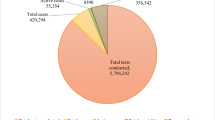Abstract
Cities are the epicenters of people and economic activities but with Covid-19 affecting both lives and livelihood, all economic activities have been brought to a grinding halt. It is important therefore for cities to understand the factors which build urban resilience to be in a better state of preparedness. The study aims to study some of the determinants of urban resilience against Covid-19 in the context of 4 large Indian cities across the first wave and second wave of the pandemic, in 2020 and 2021 i.e. Mumbai, Bengaluru, Pune and Surat. The explanatory variables for the infection which have been taken are the crowding variables (population, gross density, net density, street crowding and indoor crowding), Health resources variable (hospital beds and medical facilities), Socio-economic variables (poverty) and Environmental variables (Solid waste generated, Sewerage discharged, Water Supply and Open Spaces). The analysis is done at a granular level taking wards which is the smallest administrative unit of a city. The analysis is done using the multiple linear regression method and finding the coefficient of correlation between the dependent variable (infection rate) and independent variables under Crowding variables, Socio-Economic variables, Health Resources variables and Environmental variables. The test of an ideal urban development model, be it a compact city or a sprawling city, is its resilience to natural and manmade disasters. In a develo** nation like India, where resources are limited, it is imperative that resources are optimally used, both under normal and pandemic conditions. Crowding variables are seen to have a much stronger influence in prevention and control of the virus transmission than Socio-Economic, Health Resources or Environmental variables which justifies the stringent lockdown measures taken by the Indian government.
Access this chapter
Tax calculation will be finalised at checkout
Purchases are for personal use only
Similar content being viewed by others
References
Chu Z, Cheng M, Song M (2021) What determines urban resilience against COVID-19: city size or governance capacity? Sustain Cities Soc 75. https://doi.org/10.1016/j.scs.2021.103304
Glaeser EL (2020) Cities and pandemics: a long history. City J. https://www.city-journal.org/cities-and-pandemics-have-long-history Retrieved from. [Google Scholar]
Mishra SV, Haque SM, Gayen A (2020) COVID-19 in India transmits from the urban to the rural. Int J Health Plann Manage 35(6):1623–1625. https://doi.org/10.1002/hpm.3047
Lai KY, Webster C, Kumari S, Sarkar C (2020) The nature of cities and the Covid-19 pandemic. Curr Opin Environ Sustain. https://doi.org/10.1016/j.cosust.2020.08.008
Panda S, Ray SS (2021) Exploring urban dynamics of crowding with COVID-19 incidence a case study of Mumbai and Bengaluru city in India. J Urban Manag 10(4):345–356. https://doi.org/10.1016/j.jum.2021.08.002
Chen J, Guo X, Pan H, Zhong S (2021) What determines city’s resilience against epidemic outbreak: evidence from China’s COVID-19 experience. Sustain Cities Soc. https://doi.org/10.1016/j.scs.2021.102892
Ahmed J, Jaman MH, Saha G, Ghosh P (2021) Effect of environmental and socio-economic factors on the spreading of COVID-19 at 70 cities/provinces. Heliyon 7(5). https://doi.org/10.1016/j.heliyon.2021.e06979
Qiu Y, Chen X, Shi W (2020) Impacts of social and economic factors on the transmission of coronavirus disease 2019 (COVID-19) in China. J Popul Econ 33:1127–1172. https://doi.org/10.1007/s00148-020-00778-2
Janke AT, Mei H, Rothenberg C, Becher RD, Lin Z, Venkatesh AK (2021) Analysis of hospital resource availability and COVID-19 mortality across the United States. J Hosp Med. 16(4):211–214. https://doi.org/10.12788/jhm.3539
Cardoso EHS, Silva MSD, De Albuquerque Felix Junior FE, De Carvalho SV, De Carvalho ACPLF, Vijaykumar N, Frances CRL (18 Sept, 2020) Characterizing the impact of social inequality on COVID-19 propagation in develo** countries. IEEE Access 8:172563–172580. https://doi.org/10.1109/ACCESS.2020.3024910
von Seidlein L, Alabaster G, Deen J, Knudsen J (2021) Crowding has consequences: prevention and management of COVID-19 in informal urban settlements. Build Environ 188:107472
Sinha R, Michelsen J, Ackura E, Nije L (2020) COVID-19’s impact on the waste sector. IFC, June, https://www.ifc.org/wps/wcm/connect/dfbceda0-847d-4c16-9772-15c6afdc8d85/202006-COVID-19-impact-onwaste-sector.pdf?MOD=AJPERES&CVID=na-eKpI
Hamidi, Sabouri, Ewing (2020) Does density aggravate the COVID-19 pandemic? J Am Plann Assoc. 86(4):495–509. https://doi.org/10.1080/01944363.2020.1777891
UN-Habitat (2021) Global urban indicators database. Available https://unhabitat.org/global-urbanindicators-database
UNICEF Bangladesh (undated) Safer sanitation and hygiene. https://www.unicef.org/bangladesh/en/better-access-safe-drinking-water/safersanitation-and-hygiene
United Nations Human Settlements Programme (UN-Habitat) (2021) Cities and pandemics: towards a more just, green and healthy future. Retrieved from https://reliefweb.int/report/world/cities-and-pandemics-towards-more-just-green-and-healthy-future?gclid=Cj0KCQiA-JacBhC0ARIsAIxybyOGE9iBoWYMQbJaOD8ixfrGCxYhyUKorSOisls4Oyj8fOttWyKWaVoaAnfDEALw_wcB
Author information
Authors and Affiliations
Corresponding author
Editor information
Editors and Affiliations
Rights and permissions
Copyright information
© 2023 The Author(s), under exclusive license to Springer Nature Singapore Pte Ltd.
About this chapter
Cite this chapter
Panda, S., Ray, S.S. (2023). Exploring the Determinants of Urban Resilience Against Pandemics: Case of Four Large Indian Cities. In: Cheshmehzangi, A., Sedrez, M., Zhao, H., Li, T., Heath, T., Dawodu, A. (eds) Resilience vs Pandemics. Urban Sustainability. Springer, Singapore. https://doi.org/10.1007/978-981-99-7996-7_2
Download citation
DOI: https://doi.org/10.1007/978-981-99-7996-7_2
Published:
Publisher Name: Springer, Singapore
Print ISBN: 978-981-99-7995-0
Online ISBN: 978-981-99-7996-7
eBook Packages: Social SciencesSocial Sciences (R0)




